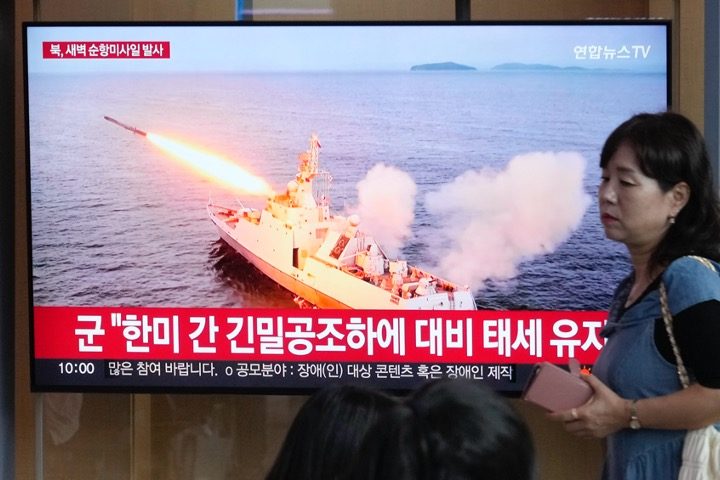
North Korea has announced that its missile launch on September 2 was actually a “tactical nuclear attack” drill staged in response to a key U.S.-South Korean military drill, which Pyongyang regards as a dry-run for a possible invasion.
“A firing drill for simulated tactical nuclear attack was conducted at dawn of September 2 to warn the enemies of the actual nuclear war danger,” North Korean state news agency KCNA reported on September 3, citing a statement by the Korean People’s Army (KPA) general staff.
During the exercise, “two long-range strategic cruise missiles tipped with mock nuclear warheads were fired in an actual war environment according to rapid approval procedures,” KCNA elaborated, lauding the strategic cruise missile-armed KPA unit for “successfully carrying out its nuclear strike mission.”
Saturday’s launch came after another military drill on August 30, in which the North Korean military simulated a nuclear attack as a “warning” to its southern neighbor in response to what it described as “adventurous [and] aggressive war exercises.”
The Korean People’s Army “staged a tactical nuclear strike drill simulating scorched-earth strikes at major command centers and operational airfields of the ‘ROK’ [Republic of Korea] military gangsters on Wednesday night,” KCNA reported, citing a statement by the KPA general staff.
The “tactical nuclear-armed unit of the KPA” fired two ballistic missiles and “correctly carried out its nuclear strike mission through air bursts at a preset altitude of 400 meters above the target island,” the statement continued.
Both nuclear drills came as South Korea and the United States ended the Ulchi Freedom Shield 23 exercises on August 31, with at least one American B-1B nuclear-capable strategic bomber flying over the Korean Peninsula.
U.S. officials stated that the military exercises were meant to boost the “combined defense posture” of South Korea and the United States and promote “security and stability in Northeast Asia.”
In contrast, Pyongyang viewed the U.S.-South Korean exercises as rehearsals for a preemptive strike and invasion, and evidence that Washington and Seoul are adopting hostile measures toward it.
KPA general staff further claimed that the bombers were practicing a “preemptive nuclear strike” against the Democratic People’s Republic of Korea (DPRK). Pyongyang’s nuclear drill is “aimed to send a clear message to the enemies,” the KPA said, “and make them clearly realize once again the DPRK’s resolute punitive will and substantive retaliation capabilities.”
North Korea has constantly slammed the U.S. and South Korea for leveraging joint military drills to prepare for a nuclear strike or a possible invasion. Pyongyang’s defense minister, General Kang Sun-nam, cautioned previously that a thermonuclear war on the Korean peninsula was almost certain unless the U.S. ditched its “hostile” behavior.
Seoul and Washington are still technically at war with Pyongyang, since the 1953 armistice only ended combat operations of the Korean War, but was never buttressed by a peace treaty. The U.S. has around 30,000 troops stationed in South Korea.
On August 27, North Korea’s leader Kim Jong Un declared that his country is poised to install atomic weapons on some of its naval vessels, pledging to make the navy a key element of Pyongyang’s nuclear deterrent.
Kim made his declaration during a visit to the North Korean navy headquarters, telling sailors that some ships would soon be equipped with “tactical nuclear weapons” and become part of the DPRK’s “state nuclear force.”
“Our navy should play the biggest role in defending the sovereignty, dignity and development and interests of the DPRK,” Kim said, based on a transcript of the speech published by KCNA. He added: “It is only possible to defend the security of the country with a fully prepared naval force.”
Kim proceeded to accuse “US imperialists” and other regional rivals of becoming “more frantic than ever before,” illustrating various instances of joint military drills between Washington, Seoul, and Tokyo in recent months.
“Owing to the reckless confrontational moves of the US and other hostile forces, the waters off the Korean Peninsula have been reduced to the world’s biggest war hardware concentration spot, the most unstable waters with the danger of a nuclear war,” Kim elaborated, also citing the permanent mobilization of U.S. nuclear assets in waters around the Korean peninsula.
Besides increased drills, the United States, Japan, and South Korea have embraced other kinds of military collaboration in the past year, including information-sharing, joint missile defense projects, and even joint nuclear planning. Pyongyang has repeatedly slammed the three allies for plotting an attack on North Korea, though Washington maintains the military actions are merely defensive.
On August 28, North Korea also criticized the plan to transfer U.S.-made F-16 fighter planes to Ukraine as a step bringing the world closer to the cusp of nuclear war between Washington and Moscow. “Their decision to supply even fighters is an anti-peace act inciting a long war and totally destroying the regional peace and stability,” Pyongyang’s Institute of International Studies cautioned in a statement reported by KCNA.
The institute proceeded to blast Washington’s “sinister intention to bring a strategic defeat to Russia at any cost.” “The reality clearly proves that the US is the arch-criminal blocking the peaceful settlement of disputes and pushing the whole of Europe into the crucible of a horrible nuclear war by inciting its followers to provide Ukraine with various kinds of lethal weapons,” the statement read.
In August, the Netherlands, Denmark, and Norway also agreed to donate F-16s to Ukraine, where the military hopes to keep its current counteroffensive against Russia going. While the U.S. refused to donate any planes of its own, the Pentagon declared that Ukrainians would begin training to fly the F-16 in Arizona in October.
Russia has repeatedly insisted that deliveries of Western weapons to Ukraine are bringing NATO members close to open conflict with Moscow.
North Korea has refused to denounce Russia for its military operation in Ukraine, and instead has repeatedly accused the United States of stoking the Russo-Ukrainian crisis.



